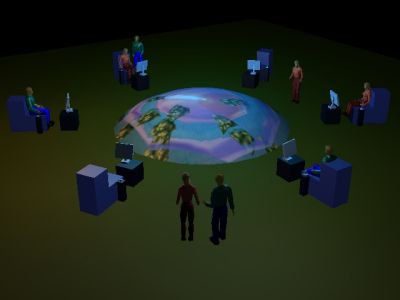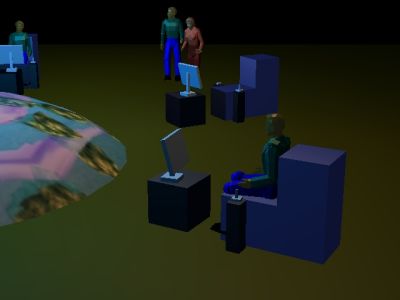


(use arrow keys to navigate, mouse to manipulate objects, esc to end)
 |
Overview of installation | |
 |
Close up view of installation | |
 |
First
Person view of prototype game
|
|
| Play
The Glass Bead
Game prototype
(use arrow keys to navigate, mouse to manipulate objects, esc to end) |
Enter
VRML walkthrough
of the installation. Dowload cosmo player first if you don't have a vrml
plugin.
|
| Description: |
| The
Glass Bead Game is a multi-user VR environment where participants interact
and play through music-making robots. Players build musical
bots that take on a life of their own in the Glass Bead world. Bots
learn and grow, changing their character as they are manipulated by players
and by each other, gradually evolving to create a complex
musical and social envirnoment. Combining artificial life, VR, and music, Glass Bead is a compelling environment where players explore, socialize, and create music through playful virtual life forms. The installation consists of six PC stations placed on comfortable, simply designed furniture, in a circle around a central domed projection screen.Each PC is networked and participating in the shared VR environment.A bird’s eye view of the environment is projected from above, on to the domed screen.The individual stations will have a first person, “in the driver’s seat” viewpoint. Bots are driven by fuzzy state machine, genetic growth, and neural network learning algorithms.As time progresses, the bot will grow and change based on neural heuristic in tandem with genetic accident.The “goal” is to create bots that learn to play well with other bots, however this is a matter of choice for the creator.Anti-social bots can and likely will be created. Bots socialize through the manipulation of body parts. A bot can play with the parts of other bots, as well as its own parts. The bot is in a sense, like a piano, whose keys are its body parts. Each "key" of the piano instead of being a string, is a digital sound sample. Sound samples ranging from recorded voice to samples from music cd’s will be sequenced and played, controlled by the movable body parts. A simple example is a scroll bar type controller that adjusts pitch. A more complex example is a multi-level checkers board where placement of checkers produces a rhythmic sequence. Each bot will have an extensive selection of sound samples to choose from, picked by the participant. Those participating from their home computers are able to upload their own sound samples to the environment. Participants will also be encouraged to bring their own samples on CD ROM to the installation, to add the sample database. Once a participant creates a bot, he or she can "occupy" the bot and control it in the environment. Other bots in the environment are unaware if a particular bot is being driven by its maker or by the computer. Likewise, a participant is unaware if other bots are being controlled by their makers. The "object" of the game is to detect what’s a bot and what’s not, the classic Turing Test executed on a level playing field. Because no literal language is employed, the differences between a bot and a human controlling a bot will be subtle. A simple example of bot behavior is its willingness to be manipulated. If a bot dislikes the way it is being manipulated by other bots, it will run away. If it enjoys it, it will follow the other bot. This is known as finite-state machine AI. If it finds itself running away frequently, yet has a strong desire to socialize, a genetic learning algorithm is employed to allow the bot to adapt and change its finite-state properties over time. When the bot is first created it is endowed with a set of deterministic parameters established by its creator. Once unleashed however, it takes on a life of its own, growing and changing. If it finds itself in a state of absolute despair, it will expire. Bot cultures and sub cultures will develop. Groups of bots will congregate and socialize based on their state machine parameters, the physical configuration of the bot, and the sequencing data the bot is generating to produce sound. Though each bot will be completely aware of the sequencing data of other bots (rhythms and timings) it is unable to actually listen to the music. This is reserved for the human participants, who can help a bot along, if it’s constantly making a cacophony. By encouraging a bot to play certain samples in favor of others, the bot will, over time, learn what sounds good and what doesn’t, given its current surroundings and its fellow bots. All bots will have a base state, the settings that it returns to if it is left alone. When playing with other bots, as it’s being manipulated, it will desire to return to its base state. It also desires to propagate its base state among the other bots. However, as it socializes, this base state will change as it determines that certain of its controllers are frequently being manipulated in certain ways. A simple example is when a bot finds that its pitch controller is often being moved to a certain range. Depending on its genetic make-up it will either adapt and conform, accepting the new pitch setting as its base, or it will refuse to adapt and the other bots will no longer play with it. Then depending on its desire to socialize, it may exist alone, in despair, and eventually expire, or just not care and become a social pariah. Experiments of
this nature have been performed in the scientific community for a number
of years, and have shown that with a relatively simple set of parameters,
a very complex behavior can result. Now that the technology to execute
simulations of this type is in the hands of non-scientists, a great deal
of creative exploration can occur. By incorporating a qualitative aspect,
the musical component, a different type of experiment is possible, that
of machine/human interaction and co-habitation. Can we show a computer
intelligence how to have "tastes?" Can a computer intelligence learn how
to distinguish noise from music? Can it learn how to create music that
humans enjoy? Can it learn social skills? Can it exhibit creative behavior,
and what do we as humans use to evaluate this creative output? Will a computer
intelligence create cultural output that we as humans can appreciate, or
will it evolve on its own terms, even though we instill it with our beliefs,
and guide it in its growth?
1999/Copyright by John Klima |